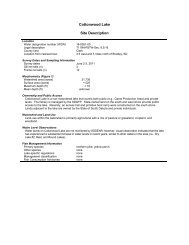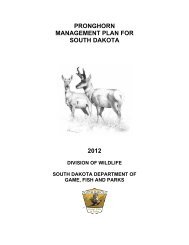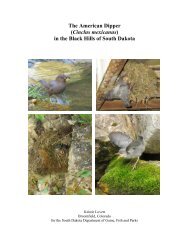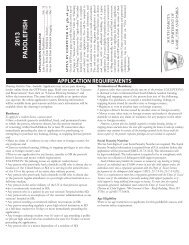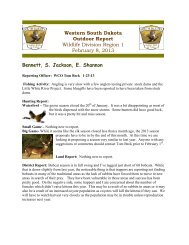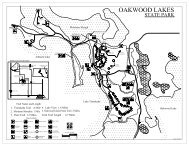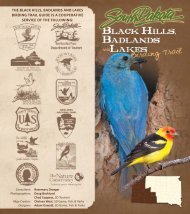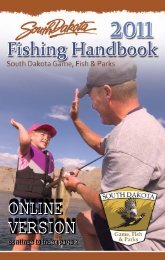pdf version - South Dakota Department of Game, Fish and Parks
pdf version - South Dakota Department of Game, Fish and Parks
pdf version - South Dakota Department of Game, Fish and Parks
Create successful ePaper yourself
Turn your PDF publications into a flip-book with our unique Google optimized e-Paper software.
Orangespotted Sunfi sh<br />
Lepomis humilis<br />
Quick key characteristics: The orangespotted sunfi sh is found in warmwater<br />
habitats. Its scales are moderate in size <strong>and</strong> readily visible. It has two<br />
elongated dorsal fi ns that are joined <strong>and</strong> appear as one, one (in front) with<br />
sharp spines instead <strong>of</strong> rays. It has three spines in the anal fi n <strong>and</strong> one in each<br />
pelvic fi n. It has a small to moderate sized, forward-facing mouth, which<br />
extends backward to the front margin <strong>of</strong> the eye. Its snout is pointed <strong>and</strong> its<br />
body is taller than wide.<br />
Similar species in <strong>South</strong> <strong>Dakota</strong>: other sunfi sh, rock bass<br />
Identifi cation: The combination <strong>of</strong> (1) a moderate-sized mouth, (2) very fl exible<br />
opercle fl ap (ear), (3) rounded pectoral fi ns, <strong>and</strong> (4) orange spots on head <strong>and</strong><br />
body distinguishes the orangespotted sunfi sh from similar fi shes in <strong>South</strong> <strong>Dakota</strong>.<br />
Range: The orangespotted sunfi sh is native among river basins that fl ow<br />
into the Gulf <strong>of</strong> Mexico. It is widespread throughout <strong>South</strong> <strong>Dakota</strong>, but<br />
more common in the east where it occupies glacial lakes, muddy ponds,<br />
impoundments, <strong>and</strong> stream pools. Western populations may be nonnative.<br />
Items <strong>of</strong> interest:<br />
• Feeds primarily on insects <strong>and</strong> crustaceans<br />
• Breeding males very brightly colored with an orange eye, breast, <strong>and</strong><br />
dorsal, pelvic, <strong>and</strong> anal fi ns; the back<br />
<strong>and</strong> sides may be bright steel blue<br />
• Males construct <strong>and</strong> defend nests <strong>and</strong><br />
guard eggs <strong>and</strong> hatchlings<br />
• Often hybridizes with other species <strong>of</strong><br />
sunfi sh<br />
• Rarely reach 6 in<br />
53






